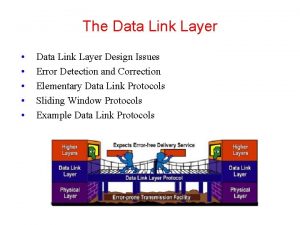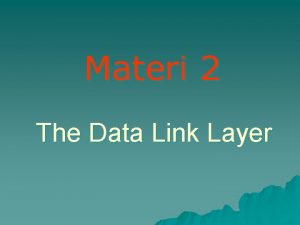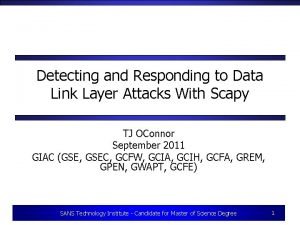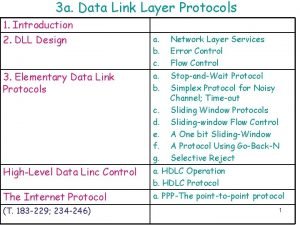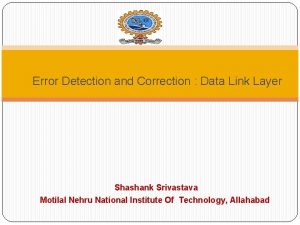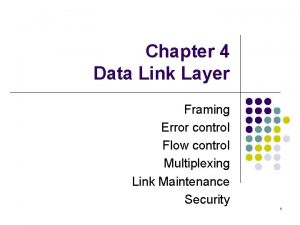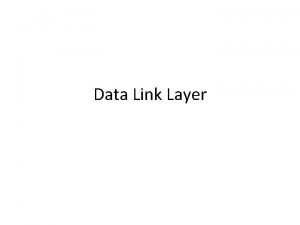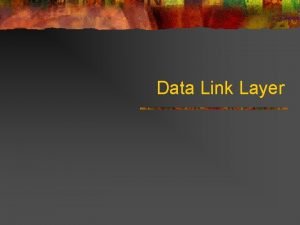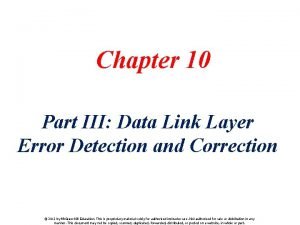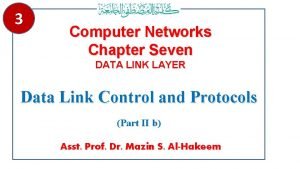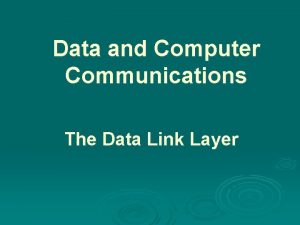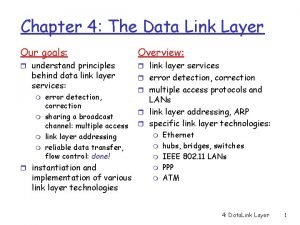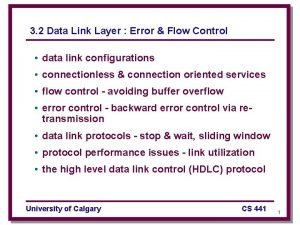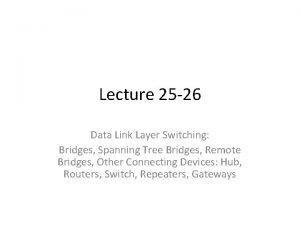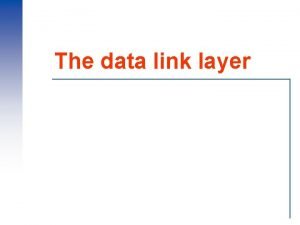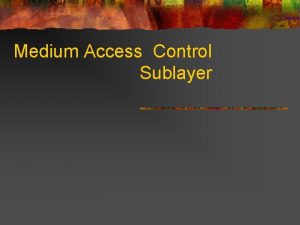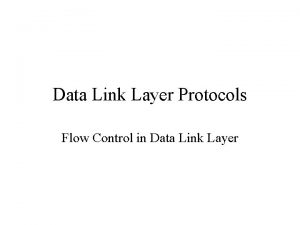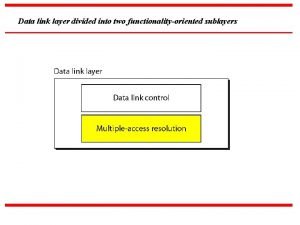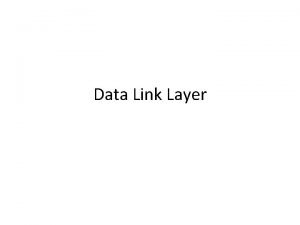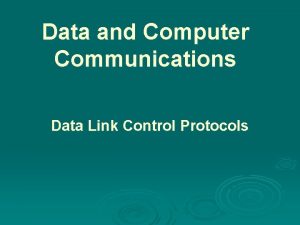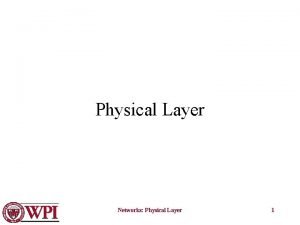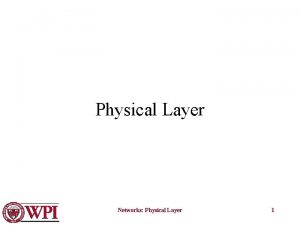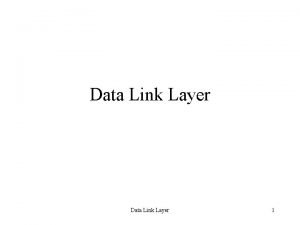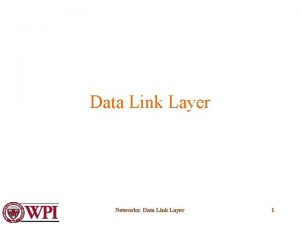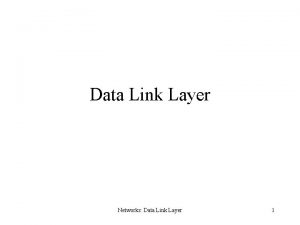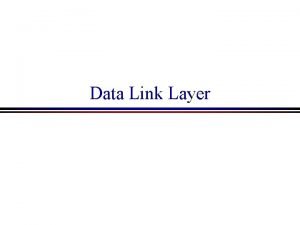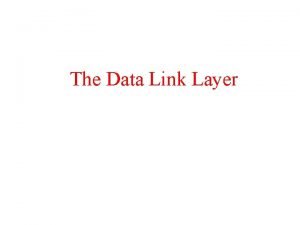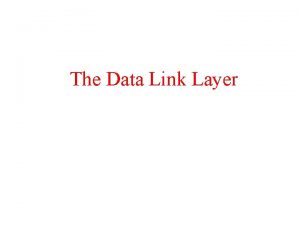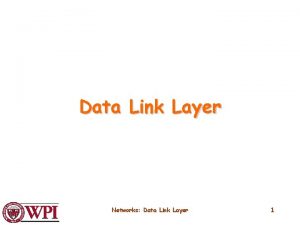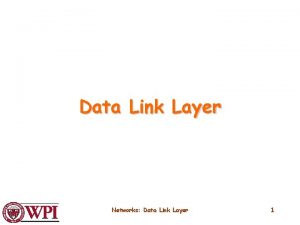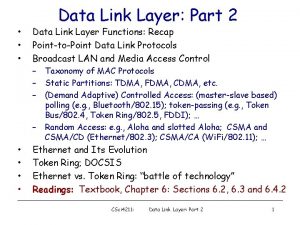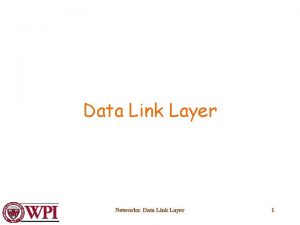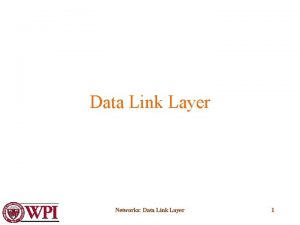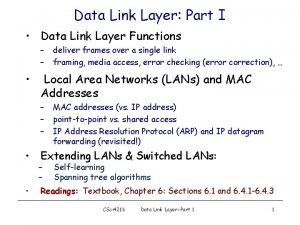Physical Media Data Link layer The main task




























- Slides: 28


Physical Media Data Link layer The main task of the data link layer is to transform a raw transmission facility into a line that appears free of undetected transmission errors to the network layer. It accomplishes this task by having the sender break up the input data into data frames. Switch and bridge work on Data link layer.

Physical Media Data Link layer The data link layer uses the services of the physical layer to send and receive bits over communication channels. It has a number of functions, including: • Providing a well-defined service interface to the network layer. • Dealing with transmission errors. • Regulating the flow of data so that slow receivers are not swamped by fast senders.

Physical Media Data Link Layer Design Issues • The data link layer has a number of specific functions it can carry out: 1. The function of the data link layer is to provide services to the network layer. 2. Framing 3. Error Control 4. Flow Control

Physical Media Elementary Data Link Layer Protocols • An Unrestricted Simplex Protocol • A Simplex Wait and Watch Protocol • A Simplex Protocol for a Noisy Channel

Physical Media Sliding Window Protocol The three protocols are bidirectional protocols that belong to a class called sliding window protocols. • A One Bit Sliding Window Protocol • A Protocol Using Go Back N • A Protocol Using Selective Repeat

Physical Media EXAMPLE DATA LINK PROTOCOLS • Here we will examine the data link protocols found on point-to-point lines in the Internet in two common situations.

Physical Media The Data Link Layer in the Internet • The Internet needs point-to-point links for these uses, as well as dialup modems, leased lines, and cable modems, and so on. • A standard protocol called PPP (Point-to-Point Protocol) is used to send packets over these links. • PPP is defined in RFC 1661 and further elaborated in RFC 1662 and other RFCs (Simpson, 1994 a, 1994 b). • Two such protocol are widely used in the internet: • SLIP- Serial line IP • PPP-Point to Point protocol

Physical Media The Medium Access Sub-Layer • Networks can be divided into two categories: • Point-to-point connections • Broadcast channels are sometimes referred to as multi access channels or random access channels. • Multi-access channel belong to a sub layer of the data link layer called the MAC (Medium Access Control) sub layer.

Physical Media The Channel Allocation Problem • How to allocate a single broadcast channel among competing users. It is of two types: • Static channel allocation in LANs and MANs • Dynamic channel allocation in LANs and MANs

Physical Media Ethernet • Ethernet is connection media access method that allows all host on a network to share the same bandwidth of a link. Two kinds of Ethernet exist: § Classic Ethernet: which solves the multiple access problem using the multiple access techniques. Ø Thick Ethernet Ø Thin Ethernet § Switched Ethernet: In which devices called switches are used to connect different computers. § Fast Ethernet § Gigabit Ethernet § 10 -Gigabit Ethernet: 10 Gbps is a truly prodigious speed, 1000 x faster than the original Ethernet.

Physical Media Classic Ethernet – Thick Ethernet: is a classic Ethernet snaked around the building as a single long cable to which all the computers were attached. – Thin Ethernet: which bent more easily and made connections using industry-standard BNC connectors. Thin Ethernet was much cheaper and easier to install, but it could run for only 185 meters per segment (instead of 500 m with thick Ethernet), each of which could handle only 30 machines (instead of 100). – Each version of Ethernet has a maximum cable length per segment (i. e. , unamplified length) over which the signal will propagate. To allow larger networks, multiple cables can be connected by repeaters. A repeater is a physical layer device that receives, amplifies (i. e. , regenerates), and retransmits signals in both directions.

Physical Media Switched Ethernet • • • Switched Ethernet: In which devices called switches are used to connect different computers. The heart of this system is a switch containing a high-speed backplane that connects all of the ports, as shown in Fig. 4 -17(b). From the outside, a switch looks just like a hub. They are both boxes, typically with 4 to 48 ports, each with a standard RJ-45 connector for a twisted-pair cable. Each cable connects the switch or hub to a single computer, as shown in Fig. 418. A switch has the same advantages as a hub, too. It is easy to add or remove a new station by plugging or unplugging a wire, and it is easy to find most faults since a flaky cable or port will usually affect just one station.

Physical Media Switched Ethernet • • • Switches only output frames to the ports for which those frames are destined. When a switch port receives an Ethernet frame from a station, the switch checks the Ethernet addresses to see which port the frame is destined for. The switch then forwards the frame over its high-speed backplane to the destination port. The destination port then transmits the frame on the wire so that it reaches the intended station. None of the other ports even knows the frame exists. In Fig. 4 -18, the port in the upper-right corner is connected not to a single station, but to a 12 -port hub instead. Hubs are simpler and cheaper than switches, but due to falling switch prices they have become an endangered species. Modern networks largely use switched Ethernet. Nevertheless, legacy hubs still exist.

Physical Media Fast Ethernet • • • Many installations needed more bandwidth and thus had numerous 10 -Mbps LANs connected by a maze of repeaters, hubs, and switches. But even with Ethernet switches, the maximum bandwidth of a single computer was limited by the cable that connected it to the switch port. The basic idea behind fast Ethernet was simple: keep all the old frame formats, interfaces, and procedural rules, but reduce the bit time from 100 nsec to 10 nsec. Technically, it would have been possible to copy 10 -Mbps classic Ethernet and still detect collisions on time by just reducing the maximum cable length by a factor of 10. The main disadvantage of a Category 3 twisted pair is its inability to carry 100 Mbps over 100 meters, the maximum computer-to-hub distance specified for 10 -Mbps hubs. In contrast, Category 5 twisted pair wiring can handle 100 m easily, and fiber can go much farther. The compromise chosen was to allow all three possibilities, as shown in Fig. 4 -19, but to pep up the Category 3 solution to give it the additional carrying capacity needed.

Physical Media Gigabit Ethernet § § § Gigabit Ethernet: Like fast Ethernet, all configurations of gigabit Ethernet use point-to-point links. In the simplest configuration, illustrated in Fig. 4 -20(a), two computers are directly connected to each other. The more common case, however, uses a switch or a hub connected to multiple computers and possibly additional switches or hubs, as shown in Fig. 4 -20(b). In both configurations, each individual Ethernet cable has exactly two devices on it, no more and no fewer. like fast Ethernet, gigabit Ethernet supports two different modes of operation: full-duplex mode and half-duplex mode.

Physical Media Gigabit Ethernet § Gigabit Ethernet: supports both copper and fiber cabling, as listed in Fig. 4 -21. Signaling at or near 1 Gbps requires encoding and sending a bit every nanosecond.

Physical Media 10 -Gigabit Ethernet § 10 -Gigabit Ethernet: 10 Gbps is a truly prodigious speed, 1000 x faster than the original Ethernet. • 10 -Gigabit Ethernet used inside data centers and exchanges to connect high-end routers, switches, and servers, as well as in long-distance, high bandwidth trunks between offices that are enabling entire metropolitan area networks based on Ethernet and fiber. • The long distance connections use optical fiber, while the short connections may use copper or fiber.

Physical Media Ethernet Cables • Ethernet uses both Data link layer and Physical layer specification. The types of Ethernet cables are: • Straight Through Cable: The straight through cable use to connect : • Host to switch or hub • Router to switch or hub • Crossover Cable: The crossover cable can be used to connect : • Switch to Switch • Hub to Hub • Host to Host • Router direct to host

Physical Media Straight Through Cable • Straight Through Cable: The straight through cable use to connect : • Host to switch or hub • Router to switch or hub

Physical Media Crossover Cable • Crossover Cable: The crossover cable can be used to connect : • Switch to Switch • Hub to Hub • Host to Host • Router direct to host

Physical Media Rolled Cable • Rolled Cable: Although rolled cable isn’t use to connect any Ethernet connection together, you use rolled Ethernet cable to a router console serial port. • Host connect to Router or Switch

Physical Media Wireless LANs • • Wireless LANs are increasingly popular, and more office buildings, airports, and other public places are being outfitted with them. The main wireless LAN standard is 802. 11. Wireless LANs can operate in one of two configurations, with a base station and without a base station. 802. 11 networks can be used in two modes. The most popular mode is to connect clients, such as laptops and smart phones, to another network, such as a company intranet or the Internet. This mode is shown in Fig. 4 -23(a). In infrastructure mode, each client is associated with an AP (Access Point) that is in turn connected to the other network. The client sends and receives its packets via the AP. The other mode, shown in Fig. 4 -23(b), is an ad hoc network. This mode is a collection of computers that are associated so that they can directly send frames to each other. There is no access point.

Physical Media Broadband Wireless • Erecting a big antenna on a hill just outside of town and installing antennas directed at it on customers' roofs is much easier and cheaper than digging trenches and stringing cables. • Thus, competing telecommunication companies have a great interest in providing a multimegabit wireless communication service for voice, Internet, movies on demand, etc. • The first 802. 16 standard was approved in December 2001. Informally the technology is called Wi. MAX (Worldwide Interoperability for Microwave Access). We will use the terms 802. 16 and Wi. MAX interchangeably. • By January 2003, 802. 16 had been revised to support non-line-of-sight links by using OFDM technology at frequencies between 2 GHz and 10 GHz. This change made deployment much easier, though stations were still fixed locations.

Physical Media Comparison of 802. 16 with 802. 11 and 3 G • Wi. MAX combines aspects of both 802. 11 and 3 G, making it more like a 4 G technology. • Like 802. 11, Wi. MAX is all about wirelessly connecting devices to the Internet at megabit/sec speeds, instead of using cable or DSL. • Wi. MAX did not start by adding low-rate data on the side of voice-like cellular networks; 802. 16 was designed to carry IP packets over the air and to connect to an IP-based wired network with a minimum of fuss. • Wi. MAX is more like 3 G (and thus unlike 802. 11) in several key respects.

Physical Media Bluetooth • Bluetooth is a proprietary open wireless technology standard for exchanging data over short distances (using short wavelength radio transmissions in the ISM band from 24002480 MHz) from fixed and mobile devices, creating personal area networks(PANs) with high levels of security. • In 1994, the L. M. Ericsson company became interested in connecting its mobile phones to other devices (e. g. , laptops) without cables. • Together with four other companies (IBM, Intel, Nokia, and Toshiba), it formed a SIG (Special Interest Group, i. e. , consortium) in 1998 to develop a wireless standard for interconnecting computing and communication devices and accessories using shortrange, low-power, inexpensive wireless radios. • The project was named Bluetooth, after Harald Blaatand (Bluetooth) II (940– 981), a Viking who unified (i. e. , conquered) Denmark and Norway, also without cables.

Physical Media Bluetooth • Bluetooth 1. 0 was released in July 1999. All manner of consumer electronic devices now use Bluetooth, from mobile phones and laptops to headsets, printers, keyboards, mice, gameboxes, watches, music players, navigation units, and more. • The Bluetooth protocols let these devices find and connect to each other, an act called pairing, and securely transfer data. • For higher data rates were added to Bluetooth 2. 0 in 2004. • The 3. 0 release in 2009, Bluetooth can be used for device pairing in combination with • 802. 11 for high-throughput data transfer. • The 4. 0 release in December 2009 specified low-power operation.

Physical Media Bluetooth Architecture • The basic unit of a Bluetooth system is a piconet, which consists of a master node and up to seven active slave nodes with in a distance of 10 meters. Multiple piconets can exist in the same (large) room and can even be connected via a bridge node that takes part in multiple piconets, as in Fig. 4 -34. An interconnected collection of piconets is called a scatternet. • In addition to the seven active slave nodes in a piconet, there can be up to 255 parked nodes in the net. These are devices that the master has switched to a low power state to reduce the drain on their batteries.
 The two main functions of the data link layer are
The two main functions of the data link layer are Data link layer design issues
Data link layer design issues Materi data link layer
Materi data link layer Karmetasploit
Karmetasploit Data link layer adalah
Data link layer adalah Data link layer switching in computer networks
Data link layer switching in computer networks Stop-and-wait arq
Stop-and-wait arq Elementary data link protocols in computer networks
Elementary data link protocols in computer networks Error detection and correction in data link layer
Error detection and correction in data link layer Data link layer design issues
Data link layer design issues Data link layer framing
Data link layer framing Data link control
Data link control Data link layer
Data link layer Issues of data link layer
Issues of data link layer Block coding in data link layer
Block coding in data link layer Data link layer protocols for noisy and noiseless channels
Data link layer protocols for noisy and noiseless channels Responsibilities of data link layer
Responsibilities of data link layer Acknowledged connectionless service
Acknowledged connectionless service Dlc in data link layer stands for
Dlc in data link layer stands for Unrestricted simplex protocol
Unrestricted simplex protocol Flow control layer
Flow control layer Data link layer switching
Data link layer switching Data link layer design issues
Data link layer design issues Fungsi physical layer
Fungsi physical layer Channel allocation problem in data link layer
Channel allocation problem in data link layer Flow control in data link layer
Flow control in data link layer Data link layer divided into two sublayers
Data link layer divided into two sublayers Data link layer framing
Data link layer framing Data link control protocols in computer networks
Data link control protocols in computer networks

